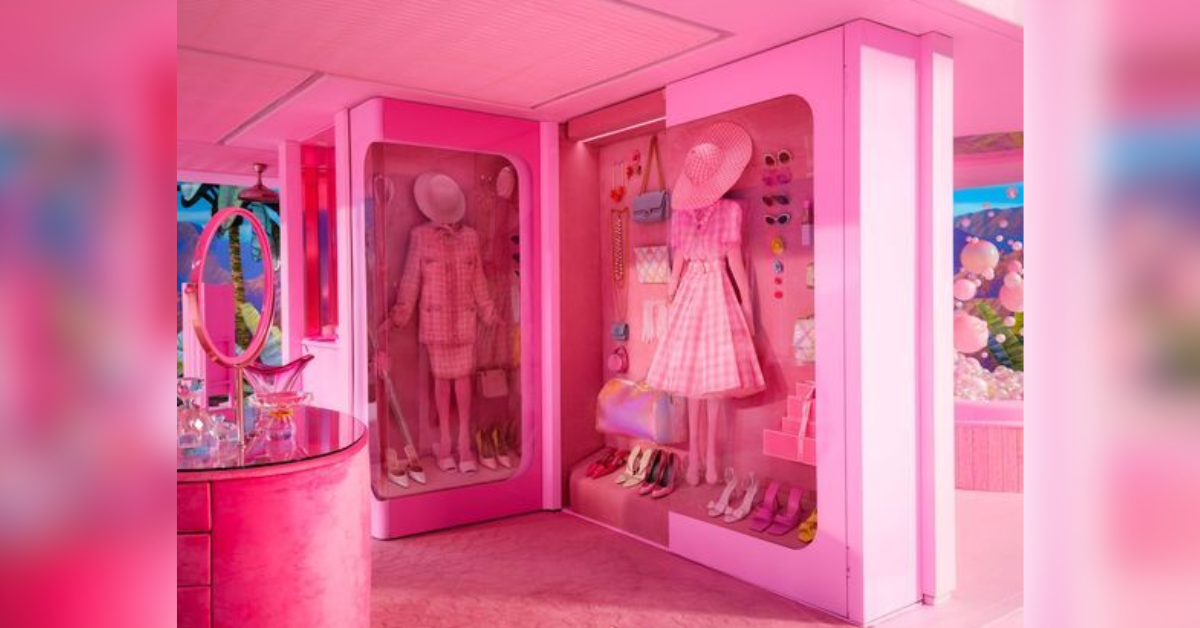Fashion in movies plays a pivotal role in many aspects of character as well as plot. There are many layers between a character’s narrative, their development and the symbolism it is portraying. It isn’t solely about how fashion is influencing the film, either – movies can significantly influence how we as the audience are dressing. There are many historical examples that we are eager to cover in this article, highlighting a few of our favorites as well as a few others’ favorites. “The clothes make the man” is taken very seriously in the world of film as for the way a character is dressed acts as a visual for who they are and how we are perceiving them.
Barbie –
Barbie, of course, is an icon! She is known for her hot pink coordinated styles as well as her black and white striped bathing suit. The Barbie movie certainly took this into consideration but made the idea of playing with a plastic doll with Velcro into a reality. There are many references to Barbie’s history that are acknowledged, but as the movie progresses, her clothes are also becoming more human-like as she transforms. This strategy is also followed in Ken’s character. Ken begins the film as a very clean cut, bright bleached-blonde with clothing that coincides with Barbie’s. After Ken visits the real-world and returns to Barbie Land, his style leans into Western and vintage sportswear. His hair also begins to grow out, revealing his darker roots (on purpose). When Barbie decides she wants to stay in the real-world, we see her exit the car in plain old Birkenstocks which was “the choice she made,” a big difference from how we see her styled in at the beginning of the film.
Clueless
The styling done in Clueless is bold, feminine and full of American youth. This was a huge influence for the ‘90s, which at the time, was experiencing the “grunge” phase, full of plaid shirts and baggy pants. Clueless set the standard for many later rom-coms we see from that era because Cher, the main character, is so memorable. When we think of this film, all we can picture is her timeless Dolce & Gabbana yellow and black skirt-blazer set. It truly was a cultural reset. There was an importance to this hyper-girly student Cher was. She was the “it-girl”, and it showed her wealth. Different from Barbie, Cher upkeeps her bold style throughout the film because through many instances, she proves that no man can change the woman that she is.
Star Wars: Revenge of the Sith
The Star Wars franchise is all about symbolism, especially in Anakin Skywalker. The first two films for the prequels show Anakin as a young Padawan, who very subtly was different from all the other Jedi. As each movie progresses, Anakin’s attire and his path becomes darker. UIS student and Star Wars enthusiast Jed Coats weighed in on the characters clothing stating: “Many of the Star Wars characters’ clothing is very literal in what they are representing, especially Anakin’s. In Episode I, Anakin is a child, very innocent. This is exemplified throughout the movie because his clothing is light or tan-coded. In Episode II and III, when we see Anakin start to show more anger and violence, his clothes and robes are dark in contrast to his mentor, Obi-Wan Kenobi, who wore lighter colored robes.” Coats also mentioned that “at the end of Episode VI, when Anakin, now Darth Vader, dies and becomes a Force ghost, somewhat redeeming himself, he is shown wearing lighter colored robes.” (Spoiler alert: Anakin Skywalker is Darth Vader). Anakin’s path has led him to the dark side, and is now introduced as Darth Vader who we all know and love from the original trilogy. “His whole suit is built to look intimidating, which is shown specifically in the helmet for his face, heavily inspired by WW II German soldiers. His armor has also taken inspiration from Japanese samurai, which shows that he is not only supposed to strike fear, but he is also a warrior,” Coats concluded.
The Devil Wears Prada
The Devil Wears Prada is a film that takes you through the life of an assistant in the fashion industry. Being that it is a fashion movie, there are a number of fashion choices that add to the plot of the movie. One of the main things that The Devil Wears Prada shows us about fashion is that it is oftentimes correlated to that of Andrea’s (Anne Hathaway) stature in the fashion world. Andrea is working for Miranda, Played by Meryl Streep, who is editor-in-chief of a fashion magazine. Originally, Andrea just took the job with Miranda in order to get journalistic experience and didn’t care for fashion at all. Throughout the course of her position, the more she starts to wear “fashionable” clothes, the higher up in her position she’s in. When she dresses better she is also starting to gain more respect from the people that she works with which shows how her value to the people in the fashion industry is only measurable by how fashionable she is instead of her ability to do her work.
Fashion is often how we get to know people and their “vibe” before getting to know them personally, which is an unfortunate but real thing.



